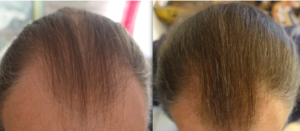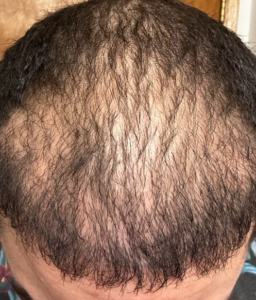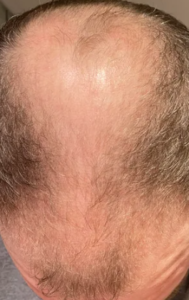I can’t tell you that balding men are more likely to get divorced, but I can tell you that when divorce occurs, many men seek a hair transplant because they want to start dating and look younger. Hair makes a man look younger.
Clogged pores is an old wives tale and does not cause hair loss
You know how with senile alopecia or DUPA, the hairs miniaturize but don’t (usually anyways) actually shrink to the point where they fall out and stop growing altogether? They miniaturize to a certain extent but then stabilize in a miniaturized state and are still retained (hence why you don’t see people with DUPA develop totally bald scalps because the hair is still there, just much thinner). Well, can the same thing occur with patterned hair loss? Where the hairs in the thinning areas of the scalp (vertex and/or hairline depending on the Norwood level) miniaturize to certain degree but then stabilize at that point and don’t continue to miniaturize to the point that they fall out and totally stop growing altogether? Or in patterned hair loss, miniaturizing hairs in a thinning area of the scalp will most definitely shrink to the point of no more growth?
You are drawing a lot of conclusions about DUPA. DUPA may be another form of Senile Alopecia or just a variation of genetic hair loss? I don’t know, but I doubt it. DUPA might progress over time, possibly leaving very little hair on the head. i have seen this in women but never seen a man with such advanced DUPA that his entire head became very thin. DUPA is different because it impacts the Donor area and every other place on the head. Someone can have genetically patterned hair loss and then develop DUPA, which I have seen. These men are in a tough spot, as their patterned hair loss may progress to full balding, leaving a fragile donor area.
Be smart about your hair. Work out a Personalized Master Plan for your future with a great hair doctor. Then you will not be a victim of your own ignorance and lose all of your hair in the process. If it is more expensive this way, it will be far cheaper down the road as the hair you lose while you play with medications based upon advice from amateurs, may never come back.
An Article published in the British Medical Journal in September 2016, based upon “two populations of men free of risk factors for erectile dysfunction and other sexual dysfunction or its treatment: men aged 40 or more with benign prostatic hyperplasia who received a prescription for a 5-alpha reductase inhibitor (finasteride or dutasteride) or alpha blocker, or both, and men aged 18-59 with alopecia”, suggests : “The incidence rate of erectile dysfunction was lowest among users of 5-alpha reductase inhibitors only (15.3 per 1000 person years, 95% confidence interval 14.3 to 16.5), and similar among users of 5-alpha reductase inhibitors+alpha blockers (19.2 per 1000 person years, 17.4 to 21.1) and alpha blockers only (20.1 per 1000 person years, 19.6 to 20.7). Compared with users of alpha blockers only, the adjusted incidence rate ratios for users of 5-? reductase inhibitors only and 5-alpha reductase inhibitors+alpha blockers were 0.92 (95% confidence interval 0.85 to 0.99) and 1.09 (0.99 to 1.21), respectively.” Of further note: “cases of erectile dysfunction were more likely than matched controls to be overweight or obese (as measured by body mass index) or to have a diagnosis of non-erectile dysfunction sexual dysfunction, hypertension, diabetes, hyperlipidemia, depression, orchitis, or alcohol misuse before the index date.” Of course, this study was done in an older population that is prone to Erectile Dysfunction
https://www.bmj.com/content/354/bmj.i4823#:~:text=The%20risk%20of%20erectile%20dysfunction%20increased%20with%20increasing%20number%20of,odds%20ratios%20were%20statistically%20significant
Comment: The risks of ED rises with age, so the groups tested were clearly at a higher risk of ED than younger men. The statistics reported by this article suggest that in this higher-risk population, the risk of ED was 1.3%, less than was reported in the original Merck study or in the Propecia ED risk factors brochures. I am wondering why so many younger men are reporting ED, considering the above statistics?
I have published on the genetics of the persistent frontal hairline. This man could bald and yet keep his frontal hairline. For a hair transplant surgeon, that means that he will not have to get the leading edge of his hair transplant, saving the patient money and donor grafts. For him, it means that he will retain a frame to his face with a good comb-back of his hair for styling purposes.
Can you please expand on what you mean by saying hair transplants accelerate balding, especially in younger men? Thank you
Younger men often don’t see their final pattern, but it is often there if they look through a hand microscope and see a lot of miniaturization present. A hair transplant causes many of these miniaturized hairs to fall out, and they RARELY come back. Remember, miniaturization doesn’t necessarily mean thread-like hair, as it could be hair that has lost only 30% of its thickness, not easily seen without extensive hand microscopic evaluation. With a 30% loss of hair thickness in most men, they will not see thinning or balding. I have seen many 23-year-old men who get hair transplants and never knew they had significant miniaturization with a miniaturization pattern that suggests a more advanced balding pattern.
Young men (under 26 years of age) who have hair transplants may see a Class 3 pattern, but they might have a Class 6 or 7 pattern, which would be a surprise. I don’t like surprises, nor should the patients. So many young me are going to Turkey, where technicians are in charge of the business. In most of these clinics, such evaluations seldom occur except for less than a dozen good doctors that I know personally. Shame on the doctors who do these surgeries without looking for and quantifying the miniaturization before they collect your money and do the surgery. Too many of today’s doctors, even in Western countries, are in it for the money and forget the oath they took when they became doctors, which states: ABOVE ALL, DO NO HARM.
I recently met with a 23-year-old male who came to me after having three hair transplants in the US at different clinics by less-than-honorable doctors. His entire donor supply was depleted, and so was his bank account. The hair transplant doesn’t even look normal to me. All of these transplants were in the first 3 inches of his hairline. When I examined the hair behind the transplanted 3 inches of his frontal area, I saw signs of miniaturization that went back to the crown. The miniaturization was very early, possibly too early to have fallen out with the transplant. He was lucky because he took finasteride, which often stops the loss of miniaturized hairs associated with a hair transplant. As this was a recent visit, I can’t tell you how it will turn out. I suspect he will live with the transplants, even with the defects of an imbalanced hairline and a lot of 2-3 hair grafts seen in the frontal edge of the hairline.
What’s the consensus about microneedling/dermarolling without using minoxidil? Does it help or is it just a waste of time (and tears)?
Microneedling works on its own. Recognize that it works by creating a wound near the stem cells in the upper part of the hair follicle that may control hair cycling. It produces a healing cascade that stimulates the stem cells as part of the cascade.
Yea doc said just not to use it. My father used minoxidil as well and he got lots of side effects just as I did. Very disappointing considering there’s barely any other options
If that was topical, he and you might be one of the 60% of men who will not respond to topical but will respond to the oral.
Post-menopausal women (50% of the feml population) often develop hair loss or diffuse thinning. Finasteride works well in some of these women; however, when a pre-menopausal woman has this condition, it may not work very well. In addition, pre-menopausal women have significant risks with this drug if they become pregnant so they should not take it with that risk over their head.
Got the 5mg pill of Finastride and am thinking of taking 1.25mg on Monday, Wednesday, and Friday, skipping Saturday and Sunday and restarting the same routine
That is essentially taking 0.54mgs daily. Merck reported that 0.5mgs is 82% as effective as the full 1mg dose, so this plan is a reasonable plan. The benefits are not the blood levels for finasteride but rather the tissue levels which hang around for a few weeks after taking the drug,
Most posts I read on various hair loss forums like Reddit, seem to be from guys who’re in their late teens/early 20’s who were probably going to be able to grow beards anyway, but for whom the minox may have just accelerated the process. Any success stories from older guys? I’m nearing 40 myself and looking for some inspiration. Much appreciated.
Men react differently to hair loss at any age. The most common reactions involve opting for very short haircuts or even shaving their heads. This trend is noticeable in places like airports or shopping centers. Some men embrace this change and never look back.
Others take a different route, seeking ways to regain their hair. Many of them share their experiences and seek solutions on platforms like Reddit or various forums. Some younger men might become fixated on their hair loss due to familial experiences.
Then, there’s a group who prefer not to rely on medications and choose the hair transplant route. They seek an immediate solution, despite the significant cost involved. I’ve performed hair transplants on men as old as 92, driven by various reasons like wanting to appear younger for dating purposes. Typically, men between 35 to 55 years old make this decision. With today’s technology, unlike older methods, about half of men can restore their hair in a single transplant session.
The crucial question here is personal: Does hair loss bother someone enough to (1) commit to lifelong medication (assuming it works), or (2) opt for a hair transplant despite the cost?
There are numerous success stories addressing hair loss, many of which are shared on platforms like Reddit. Are you bothered enough to go through treatments such as daily medications or a hair transplant. Only you can answer this question.
Derma-rollers are something I’ve overlooked but seeing as how they’re so popular here I think I’ll give it a try. Thing is, I’m not quite sure how to tell if one is good or not. I did read that 0.5mm is the ideal starting size, used once a week, but other than that is there anything else I should know about? I’ve heard the titanium ones are better than stainless steel. Also, are the rollers better or worse than the derma stamps? I have large diffuse thinning, not just a local spot.
And does the brand matter? Any brand or model recommendations?
Microneedling is best done with a reciprocating needle device like the Dr. pen device, which has 36 needles and a depth of 1.25mm. Using once a week is the best way to go. You can hold it in a single area for a defined period, like 10 seconds, which delivers a known injury. This injury starts a healing cascade that brings in or activates the stem cells found in the upper part of the hair follicles or in the upper part of the dermis at a depth of about 1 mm.
Page 30 of 1234




